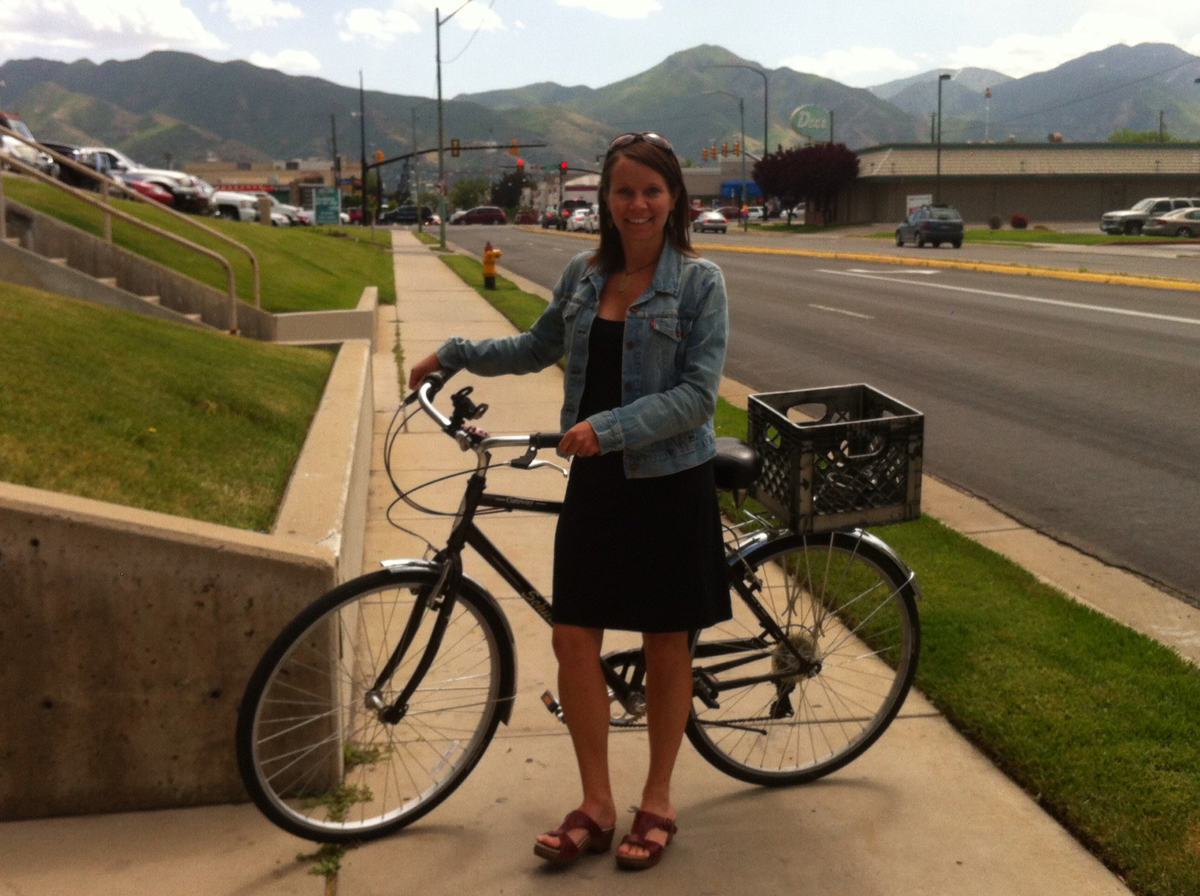By Charles Pekow — National forests offer more mountain bike miles than anywhere. The five national forests in Utah and nine in Idaho provide more than their share. But good luck trying to ride a trail without stumbling over a branch, finding a fallen or charred tree trunk in the way, getting a bigger bounce than you want from a pothole, sharing the road with a heap of garbage or finding a segment of the trail washed away. If you manage to avoid those, maybe you’ll find a bridge out.
That’s because the U.S. Forest Service (USFS) isn’t keeping its trails up to par. Far from it.
In June 2013, the Government Accountability Office (GAO) officially reported what many trail users long knew: the “Forest Service has more miles of trail than it has been able to maintain, resulting in a persistent maintenance backlog with a range of negative effects.”
National forests include about 158,000 miles of trails – making it the largest custodian of mountain bike miles in the country. But in Fiscal Year 2012, USFS only did any maintenance work on 37 percent of them. It can only afford to do any work on about a third of its trails annually and some trails received no care for a decade. And the percentage of trails cared for includes those that got minimal work – such as pruning brush as opposed to repairing eroded stretches. USFS estimated its maintenance backlog last year to total $314 million – in addition to another $214 million backlog for general operations and capital improvement. USFS budgets about $80 million a year for trail maintenance (though it does some trail work with other funding and volunteer work). Only 26 percent of its trails meet the Forest Service’s own standards. The problem didn’t spring up recently. Back in 1989, the agency had fallen $200 million behind in trail upkeep.
And these figures may underestimate the extent of the problem because USFS lacks enough adequately trained staff to inspect and evaluate all its trails.
But more than a lack of money is causing USFS trail problems.
One inherent problem stems from the fact that many national forest trails used for mountain biking weren’t designed for that purpose – or for recreational use at all. USFS converted many trails originally built as logging or mining roads or as access routes for firefighters or transportation to remote areas. Some were built on steep slopes that make them prone to erosion. Trails may lead riders through environmentally sensitive areas or places not the most desirable to ride.
Another problem GAO found: “Many officials noted that the Forest Service has no career path or training programs for trails staff, which makes it difficult for the agency to develop and retain professional expertise and leadership for the trails program,” its report says. Managers wind up using summer help, which means they have to train a new crew every year to use crosscut saws, blast rock, work with horses and so on.
USFS staff also complained about everything from inability to pay lodging costs (so crews have to spend hours commuting to and from remote sites when they could be working), the need to perform lengthy environmental reviews, bad weather and Congress’ routine failure to provide not only enough money – but appropriate it on time, which makes planning impossible. Most years, Congress hasn’t passed full-year funding bills by the start of the fiscal year.
In many cases, the Forest Service could save money in the long haul by replacing unsustainable trails with sustainable ones. But the agency as a whole hasn’t done much to study trail sustainability because in the short run “such assessments – and subsequent changes to trail systems – can be costly, time-consuming, and contentious,“ GAO notes.
GAO also faulted USFS for not standardizing trail maintenance training and procedures.
And while USFS valued the volunteer labor it got in FY 12 at $26 million, the time spent working with volunteers took away from the time professional staff could actually spend on trail maintenance themselves.
GAO researchers also reported that USFS staff told them that volunteer groups can turn into adversaries when land managers make a decision they don’t like, such as closing a trail for environmental reasons. Volunteer groups can also feel they should have a say in management decisions if they provide the bulk of the labor.
In a response to GAO, USFS Chief Tom Tidwell wrote that “limited budgets are a reality” and that agency resources are strained by the need to put out literal forest fires, leaving less for figuratively fiery messes that don’t involve flames. He noted that “there is always greater demand for resources than what is available.” Tidwell wrote that the service “is committed to improve policies and procedures related to trail maintenance, including implementing the electronic collection of trail condition and prescription data.” He promised to look for ways to help managers recruit and retain employees with trail building expertise.
Some local trail users traveled to Washington recently to complain to Congress. They spoke to Rep. Rob Bishop (R-UT) at a hearing of Bishop’s Natural Resources Subcommittee on Public Lands & Environmental Regulation. Greg Martin, a director of the Wood River Bike Coalition and the Wood River trails coordinator for the Blaine County Recreation District (BCRD), made the trip from Idaho. He spoke of the economic importance of the recreational area.
“High quality trail experiences for mountain bicycling and other trail user groups are a critical component of successful outdoor recreation destinations such as Sun Valley,” Martin testified. He noted that USFS and the community are working on turning a ski lift into a mountain bike lift when seasons change.
But, he said, the area suffers from the hodge-podge of trails when it needs a plan. “It is rare that we see a deliberate effort to plan how a trail system interacts with the landscape or how uses are managed to provide a specific experience. Managing trails based on desired experiences, sustainable construction and maintenance, and suitability for the desired conditions of the area rather than simply by mode of travel would allow the agencies to actually manage a trail system rather than a spider web of legacy routes,” he testified.
Martin noted that because of the differing maintenance policies of USFS, the Bureau of Land Management, the county and the state, mountain bikers don’t get a consistent ride.
“One of the main problems we are having is in places where there has (been) a fire – the Forest Service has no extra funding to repair the trails after the fire. In one place, there were 100 downed trees in one mile,” states Ashley Korenblat, president of bike tour operator Western Spirit Cycling.
So how do we better sustain USFS’ mountain bike trails?
At the end of the hearing in late June, Bishop pledged to come up with “options and recommendations” for increasing mountain biking and other recreation in national forests and other public lands. At the end of July, he hadn’t yet come up with anything.
But trail users and governments don’t have to wait for the perpetually slow Congress.
GAO suggests a few ways. To start, USFS needs to assess its trail system, the resources it devotes to them and quantify the gap between the two.
Then USFS needs to improve its policies and procedures. Three years ago, the agency developed A Framework for Sustainable Recreation to do just that. But it hasn’t used it for trail maintenance.
Specifically, the Forest Service needs to improve its training and volunteer programs. GAO’s report states that “the agency has not established collaboration with and management of volunteers who help maintain trails as clear expectations for trails staff responsible for working with volunteers, and training in this area is limited.”
A few national forests and local supporters have found innovative ways to fund trail maintenance, including using Recreational Trails Program funding, and grants from Title II of the Secure Rural Schools & Community Self Determination Act. The act, as reauthorized last year, allows counties containing national forests to use funding to maintain the forest infrastructure. Grantees in several states, including Idaho, have also used prison crews as labor. In one case, USFS paid the prisoners only 50 cents a day, according to GAO. Other places earmark user fees or state off-road vehicle fees for trail maintenance and get private grants. Manufacturers and distributors of sporting equipment are keen on making sure people can find adequate places to use their products and will donate funds for the purpose.
Also, some forests are using American Recovery and Reinvestment Act Funding for trail maintenance, including seven in Idaho totaling about $9.2 million.
And this year, the city of Victor, ID and partners received a Federal Lands Aces Program grant of about $1.3 million for the Idaho Teton Centennial Trail Project. It will build a 1.9-mile paved trail along state Hwy. 33 from the Wyoming border to the Caribou-Targhee National Forest. Not quite in the forest but it will help cyclists get there. The project includes providing trailhead info and interpretive signs. The city and partners are putting up about 10 percent of the costs. The Federal Highway Administration gives grants under the program to improve transportation to federal lands, as authorized under the controversial Moving Ahead for Progress in the 21st Century (or MAP21) Act. Who says there aren’t opportunities for bicycling under the act?
Some other rays of hope are shining. In Idaho, the Sawtooth National Recreation Area, which includes three national forests, is planning to improve conditions for all levels of riders. Management decided in July to add 30 miles of non-motorized trails and officially designate about 14.7 miles of existing trails as official single-track mountain bike routes. “The purpose of the projects is to provide a more desirable summer trail network in the Galena Lodge resort area with emphasis on beginner and intermediate trails,” explains Area Ranger Joby Timm in a letter announcing the decision. (In late July, the decision was subject to appeal should anyone object.)
The plan calls for making the lodge and nearby trailhead the focus for summer recreation. The project involves the type of collaboration advocates want – between USFS and BCRD on everything from maintaining trails and providing parking to signage, educating the public and minimizing conflicts with grazing sheep.
Teton Valley Trails & Pathways (TVTP), a community group dedicated to developing hiking and biking trials in eastern Idaho has been working for a decade rather successfully to build trails in the Caribou-Targhee National Forest. “We have three volunteer days a year” in which about 130 people donate between 1,200 and 1,500 hours of work, relates Executive Director Tim Adams. In addition to sawing and clearing brush, TVTP works with USFS on developing “travel plans” for official motorized and non-motorized routes appearing on the forest’s official maps. If a trail doesn’t appear on the plan, it’s not supposed to be built. “We work with different groups: equestrians, hikers, bikers, joggers, motor sports” to increase popular support for trails, Adams says.
To stretch the declining budget, the value of the volunteer labor can be used as a match when seeking other grants that require local contributions, Adams notes. And a few TVTP members know their stuff and can teach and supervise other volunteers to use equipment and work safety. “Because we have done this 10 years, we have a crew of around 30 people that have been doing this for so long” that they can do the supervisory work the understaffed ranger crews can’t afford time for. “They can have two or three Forest Service people when we have 30 people on the trail,” Adams explains.
But he acknowledges that trail users have conflicted sometimes with rangers and wanted to use trails not in the plans.
And trail planners sometimes have to take into account the needs of users who can’t speak at the public forums. “At Mill Creek in Teton Canyon, there was an issue with migration of bears. We worked really closely with environmentalists and how close we could go to the migratory corridor,” Adams recalls.








